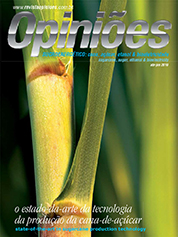Godofredo Cesar Vitti
Professor of Soil Fertility, Fertilizer and Fertilizing at Esalq-USP
Op-AA-24
Sugarcane nutrition and fertilizing
The fertilizing of sugarcane is defined by the culture’s (plant’s) nutritional need, subtracting the nutrients supplied by soil and multiplying by a fertilizing efficiency factor (f).
Fertilizing = (Plant-Soil)xf
Factor (f) results from the “competition” between the system (soil-plant-atmosphere) with the sugarcane plant for the applied fertilizer. This competition, expressed as losses, may occur due to: Erosion, Lixiviation, Fixation, Volatilization and biological Denitrification of NO3. Admissible for N, P2O5 and K2O of 50 to 60, 20 to 30 and 70%, thus corresponding to factor (f) of 2; 3 to 5 and 1.5, respectively, in a conventional system. For dimensioning the plant factor, one must answer the question: what, how much, when and how to apply the necessary nutrients for the culture’s maximum output, while the soil factor should preferably be assessed by soil analysis.
1. Chemical soil management:
1.1. Liming:
a. Sugarcane: Calculate the need for liming using the criterion of base saturation, applying the following formula: NC in t ha-1=[(60-V1)xCTC(1)]+[(60-V1)xCTC(2)]/(PRNTx10), where:
NC=need for lime, in t ha-1;
V1=base saturation defined in soil analysis;
CTC=cation exchange capacity, in mmolc dm-3; PRNT=relative lime neutralization power, in %;
(1)=layer of 0 to 25 cm;
(2)=layer of 25 to 50 cm.
b. Ratoon: Apply the formula NC in t ha-1=[(60-V1)xCTC]/(PRNTx10), considering only the layer of 0 to 25 cm due to the superficial incorporation with the cultivator, or without incorporation. The application of more than 3 t ha-1 per year is not recommended.
1.2. Plastering: Apply the criteria below, recommended for plastering on both the sugarcane plants and the ratoons, considering the result of the 25 to 50 cm layer analysis.
a. Sub-surface conditioner: NG in t ha-1=[(50-V1)xCTC]/500, where:
NG = need for plaster, in t ha-1;
V1=base saturation as per 25 to 50 cm layer soil analysis;
CTC=cation exchange capacity of the 25 to 50 cm layer, in mmolc dm-3.
b. Sulfur source: Apply 1 t ha-1 of plaster, to supply 150 kg ha-1 of S, sufficing for about 3 cuts (50 kg ha-1 of S per cut), when plastering is not necessary to condition the sub-surface.
1.3. Phosphating: This practice is more important with sandy soils (low CTC) with low phosphate content (Presin ≤ 15 mg dm-3). The dose is of 5.0 kg of P2O5 per each percent of clay in the soil, corresponding to range 100 (clay ≤ 20%) to 150 kg ha-1 of P2O5 (clay 25 to 30%), applied in the whole area, after liming and plas-tering and before grading (superficial incorporation).
1.4. Green fertilizing: Green fertilizing upon reforming the plantation is a mandatory practice, since it has several effects, such as protecting the superficial soil layer and acting in the faster solubilization of nutrients contained in the correctors. It is recommended to plant: Crotalarias junceae or spectabilis, soybean or peanuts.
1.5. Organic fertilizing: The most applied coproducts are filter cake, vinhasse, ash, applied: in natura, “conditioned” or “enriched”, mainly as sources of P2O5, with their main application on the sugarcane plant, to supply all the N and P2O5, complemented by K2O.
2. Mineral Fertilizing:
2.1. Fertilizing on planting: Basic fertilizing in the plant-ing furrow is 40 to 60 kg ha-1 of N; at least 150 kg ha-1 of P2O5, 120 kg ha-1 of K2O (complementing upon chunk breaking if necessary), 2 kg ha-1 of Zn and 1 kg ha-1 of B.
2.2. Fertilizing ratoons:
a. Burnt sugarcane: One applies about 1.0 kg of N t-1 of harvested cane and 1.3 (K from soil > 1,5 mmolc dm-3) to 1.5 (K of soil < 1,5 mmolc dm-3) kg of K2O t-1 from cane, with the relation N/K2O in the range from 1.0 to 1.3 to 1.5.
b. Green cane: Increase the dose of N by about 30%, i.e., 1.3 kg t-1 of N in cane produced, and as a source for N apply urea on the surface using urease inhibitors or ureia mixed with ammonium sulfate to reduce N losses due to volatilization. With respect to potassium fertilizing, one notices that the straw blanket frees about 40 to 50 kg ha-1 of K, which must be subtracted from the mineral fertilizing. Thus, the dose of K2O in green cane may lie between 0.8 to 1.0 kg of K20 t-1 of harvested cane.
Apart from applying plaster as a source of S, sulfur may be supplied as Simple Superphosphate, Thermophosphate, Magnesium Multiphosphate, Ammonium Sulfate, or through vinasse, “Ajifer” or “Sulfuran”.
3. Mineral Fertilizing with Micro-nutrients:
The application of micro-nutrients may be done through soil, incorporated into the P2O5 grain or by coating all granules of N, P2O5 and K2O, in doses of 3 to 5 kg ha-1 of Zn, of 2 to 3 kg ha-1 of Cu and of 1 to 2 kg ha-1 of B, the smaller doses being for sandy soils and the larger for claylike ones; through herbicide, specifically for B in the form of boric acid in the dose of 750 g ha-1 of B, or through clumps, in the dose of 300 to 350 g ha-1 of B (boric acid), 400 (Cu) and 750 (Zn) g ha-1 (salts, chelates, phosphites or humic and fulvic acids).
4. Conclusion:
Chemical soil management for high sugarcane productivity starts with soil sampling and analysis, continues with corrective practices (liming, plastering and phosphating, conservationist practices (green fertilizing and sugarcane harvesting without burning), and organic fertilizing, and finishes with mineral fertilizing with macro- and micronutrients.




